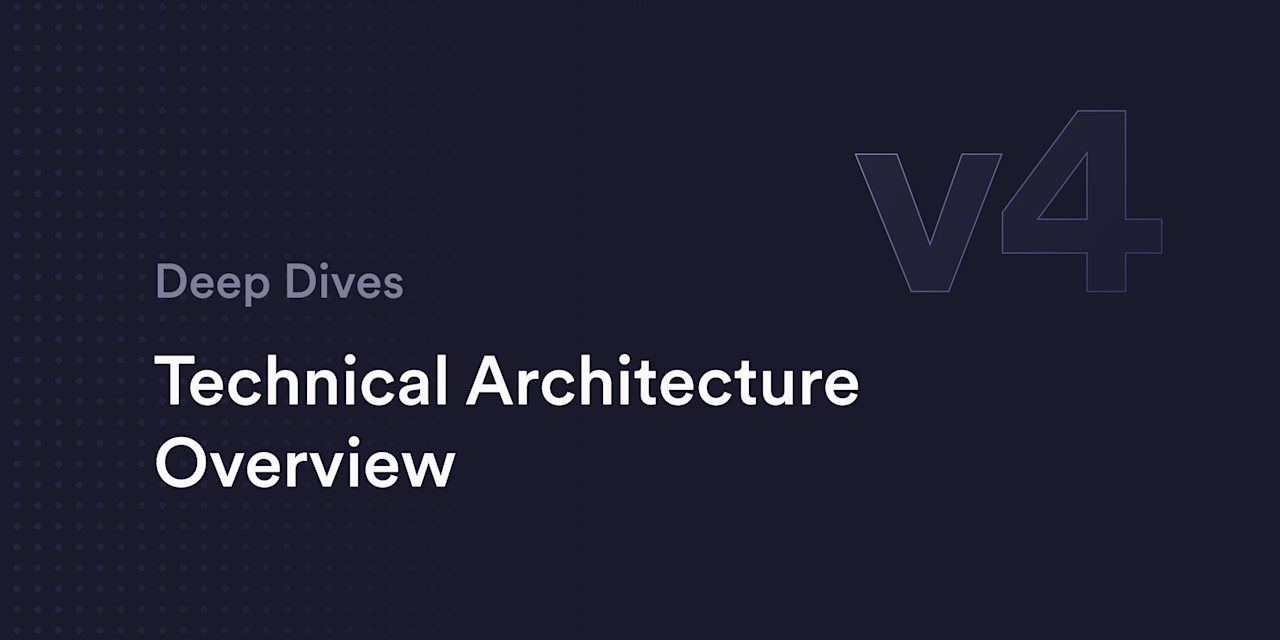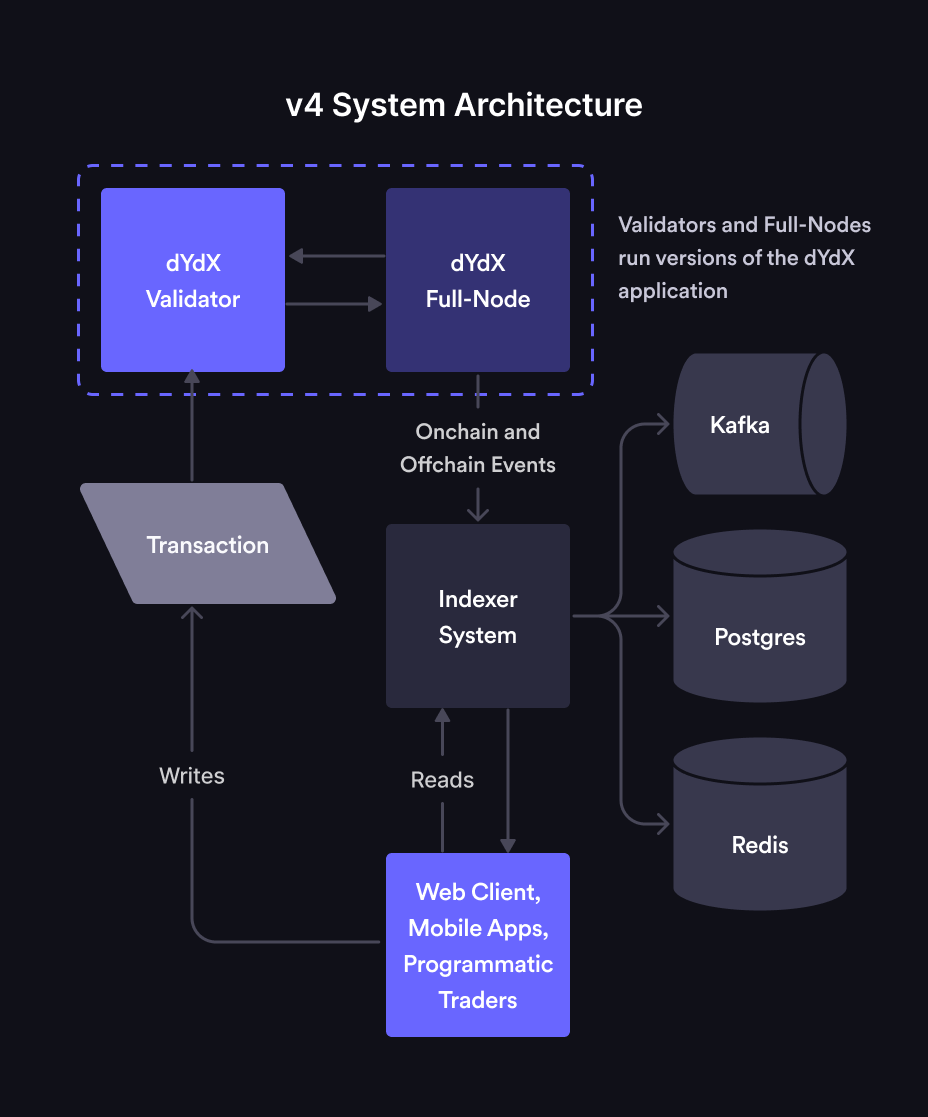


Intro to dYdX v4 Architecture
v4 (or dYdX Chain) is the next iteration of the dYdX protocol, which will consist of open-source software. The current version live in production today is known as v3 and can be found here. v3 and past versions of dYdX were, at their core, smart contracts deployed to existing chains, combined with centralized services hosted in the cloud. v4 will be a standalone L1 blockchain, featuring a fully decentralized, off-chain orderbook and matching engine. The dYdX Chain will be based on the Cosmos SDK and CometBFT PoS consensus protocol.
As we approach the release of v4 mainnet open-source software (“dYdX Chain”), we want to provide a peek into what the dYdX team is building. This post presents a high-level overview of the architecture of v4. Given that v4 is still under development, please note that what is presented below is subject to change.
v4 System Architecture
dYdX v4 is being designed to be completely decentralized end-to-end. The main components broadly include the protocol, the Indexer, and the front end. Each of these components will be made available as open source software. None of the components will be run by dYdX Trading Inc.

Protocol (or “Application”)
The open-source protocol is an L1 blockchain built on top of CometBFT and using CosmosSDK. The node software is written in Go, and compiles to a single binary. Like all CosmosSDK blockchains, v4 uses a proof-of-stake consensus mechanism.
The protocol will be supported by a network of nodes. There are two types of nodes:
Validators: Validators are responsible for storing orders in an in-memory orderbook (i.e. off chain and not committed to consensus), gossipping transactions to other validators, and producing new blocks for the dYdX Chain through the consensus process. The consensus process will have validators take turns as the proposer of new blocks in a weighted-round-robin fashion (weighted by the number of tokens staked to their node). The proposer is responsible for proposing the contents of the next block. When an order gets matched, the proposer adds it to their proposed block and initiates a consensus round. If ⅔ or more of the validators (by stake weight) approve of a block, then the block is considered committed and added to the blockchain. Users will submit transactions directly to validators.
Full Nodes: A Full Node represents a process running the v4 open-source application that does not participate in consensus. It is a node with 0 stake weight and it does not submit proposals or vote on them. However, full nodes are connected to the network of validators, participate in the gossiping of transactions, and also process each new committed block. Full nodes have a complete view of the dYdX Chain and its history, and are intended to support the Indexer. Some parties may decide (either for performance or cost reasons) to run their own full node and/or Indexer.
Indexer
The Indexer is a read-only collection of services whose purpose is to index and serve blockchain data to end users in a more efficient and web2-friendly way. This is done by consuming real time data from a v4 full node, storing it in a database, and serving that data through a websocket and REST requests to end-users.
While the v4 open-source protocol itself is capable of exposing endpoints to service queries about some basic on-chain data, those queries tend to be slow as validators and full nodes are not optimized to efficiently handle them. Additionally, an excess of queries to a validator can impair its ability to participate in consensus. For this reason, many Cosmos validators tend to disable these APIs in production. This is why it is important to build and maintain Indexer and full-node software separate from validator software.
Indexers will use Postgres databases to store on-chain data, Redis for off-chain data, and Kafka for consuming and streaming on/off-chain data to the various Indexer services.
Front-ends
In service of building an end-to-end decentralized experience, dYdX is building three open-source front ends: a web app, an iOS app, and an Android app.
Web application: The website will be built using Javascript and React. The website will interact with the Indexer through an API to get off-chain orderbook information and will send trades directly to the chain. dYdX will open source the front end codebase and associated deployment scripts. This will allow for anyone to easily deploy and access the dYdX front end to/from their own domain/hosting solution via IPFS/Cloudflare gateway.
Mobile: The iOS and Android apps are built in native Swift and Kotlin, respectively. The mobile apps will interact with the Indexer in the same way the web application does, and will send trades directly to the chain. The mobile apps will be open sourced as well, allowing anyone to deploy the mobile app to the App Store or Play store. Specifically for the App store, the deployer will need to have a developer account as well as a Bitrise account to go through the app submission process.
Lifecycle of an Order
Now that we have a better understanding of each of the components of dYdX v4, let’s take a look at how it all comes together when placing an order. When an order is placed on v4, it will follow the flow below:
User places a trade on a decentralized front-end (e.g., website) or via API
The order is routed to a validator. That validator gossips that transaction to other validators and full nodes to update their orderbooks with the new order.
The consensus process picks one validator to be the proposer. The selected validator matches the order and adds it to its next proposed block.
The proposed block continues through the consensus process.
If ⅔ of validator nodes vote to confirm the block, then the block is committed and saved to the on-chain databases of all validators and full nodes.
If the proposed block does not successfully hit the ⅔ threshold, then the block is rejected.
After the block is committed, the updated on-chain (and off-chain) data is streamed from full nodes to Indexers. The Indexer then makes this data available via API and Websockets back to the front end and/or any other outside services querying for this data.
The flow above is a high level overview of how an order/data will move through v4. We will do further deep dives into the protocol, indexer, and various front ends’ infrastructure in subsequent blog posts as we get closer to the release of v4 mainnet open-source software.
About dYdX and Terms
Here at dYdX, our mission is to democratize access to financial opportunity. We believe that v4 software will represent notable progress in service of that mission. The events in the global economy that have transpired over the last year have only reinforced the need for open, transparent, and permissionless financial products. We’re excited for v4 software to better meet those needs.
If building the future of a decentralized exchange and open finance is something you’re interested in, check out what it’s like to work at dYdX and our open roles!
To ask additional questions, join the discussion on Discord, participate in the dYdX community, or follow us on Twitter. We’re excited to continue building the dYdX Chain and will continue to release updates over the coming months.
Terms and Conditions: This post is subject to the dYdX Terms of Use. The dYdX interface and products are not available to persons or entities who reside in, are located in, are incorporated in, or have registered offices in the United States or Canada ("Blocked Persons"), or other Restricted Persons (as defined in the dYdX Terms of Use). dYdX products and services are not intended for, and should not be used by, Blocked Persons or Restricted Persons. Terms of Use specific to v4 software can be found here.